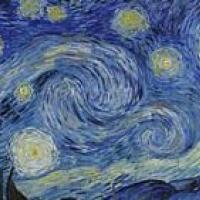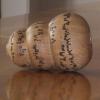
Makers of patterns: Mathematics and art
"A mathematician, like a painter or poet, is a maker of patterns. If his patterns are more permanent than theirs, it is because they are made with ideas."
This quote from the mathematician GH Hardy points to the communalities between mathematics and art. Exploring these similarities can lead to a rich dialogue between artists and mathematicians. A recent workshop called Space, scale and scaling in art, which took place at the Isaac Newton Institute for Mathematical Sciences (INI) in Cambridge, did just that, and also looked at how techniques from maths and science can help us understand the power of art and explore its history.
This collection of content brings together some of our favourite content on the intersection on maths and art, including an interview with the organisers of the INI workshop. We hope you enjoy it.
Space, scale and scaling in art
The art of maths and the maths of art – In this episode of our podcast two of the organisers of the INI workshop, physicist Andrzej Herczyński and mathematician Paul Glendinning, talk about their motivation for putting it on and some of the art that was discussed.
Mathematics and visual art

Fractal expressionism – This article looks at fractal structures in works by the abstract expressionist Jackson Pollock, who is discussed in the interview above. For a follow-on article see here.

String theory, duality and art – This article explores a fascinating collaboration between theoretical physicist David Berman and Turner Prize winning artist Grenville Davey, who was artist in residence at the INI in 2012. For a review of a show by Davey see here.
Troubled minds and perfect turbulence – This article reveals how the swirly patterns in paintings by Vincent van Gough mimic turbulent motion found in nature.
You can see all our content on maths and art see here.
Mathematics and music
Sine language – In this article we meet a song by our musician friend Oli Freke which explores the idea of sine waves, and how they relate to other concepts such as the Western tuning system and even to ancient Greek cosmological ideas.
Fractal music – In this article composer Dmitry Kormann explains how he brings fractal-like patterns to the very structure of his music, with beautiful results.
From clicks to chords – How is frequency related to pitch? Musician Oli Freke explains, letting music emerge from pure mathematical beats. You can also listen to an interview with Oli in our podcast.
Maths in a minute: Maths and music – This is a quick introduction to the links between mathematics and music.
You can see all or content on maths and music see here.
Mathematics and architecture
Swimming in mathematics – The beautiful structure that housed the swimming events at the 2008 Olympic Games is based on a mathematical question: what is the most efficient way to divide a space into cells of equal volume, but with a minimal surface area?
How the velodrome found its form – Another Olympic masterpiece, this time for cycling events at the 2012 Olympics, found its shape through the interaction of purpose and aesthetics.
Maths in a minute: The Sydney Opera House – The geometry of spheres guides the design of this iconic structure.
Perfect buildings: The maths of modern architecture – Find out how parametric modelling enables architects to construct buildings that are beautiful, fit for purpose, and environmentally friendly.
You can see all or content on maths and architecture see here.
This content was produced as part of our collaboration with the Isaac Newton Institute for Mathematical Sciences (INI) – you can find all the content from our collaboration here. The INI is an international research centre and our neighbour here on the University of Cambridge's maths campus. It attracts leading mathematical scientists from all over the world, and is open to all. Visit www.newton.ac.uk to find out more.
